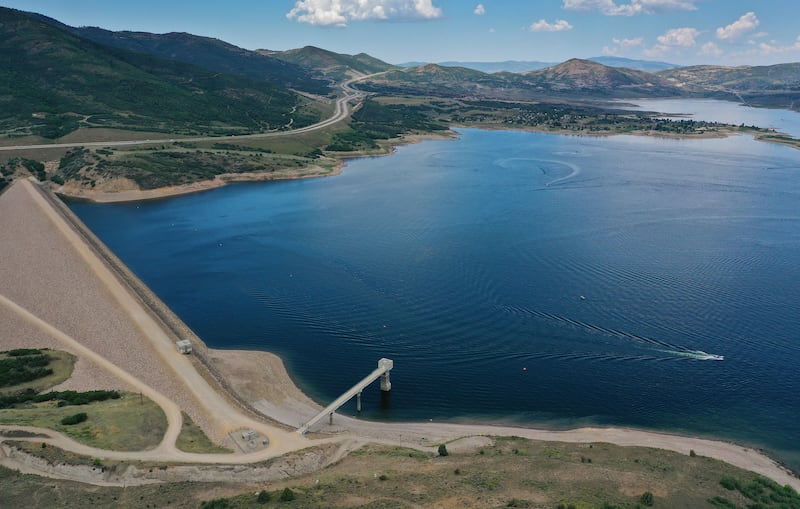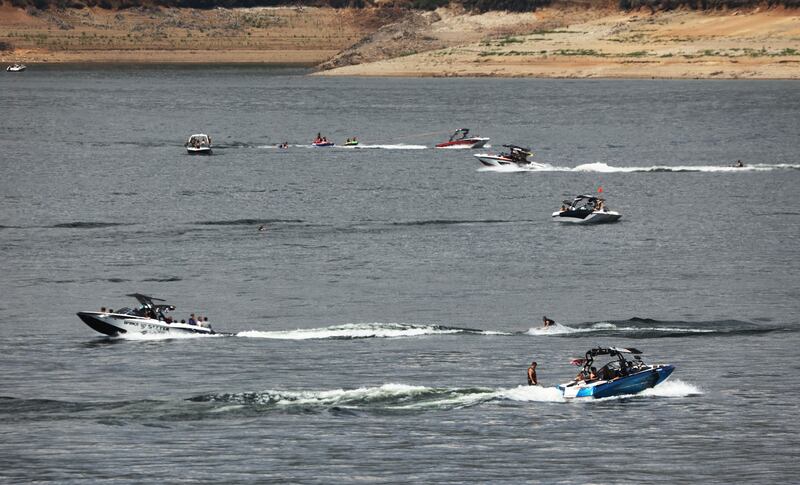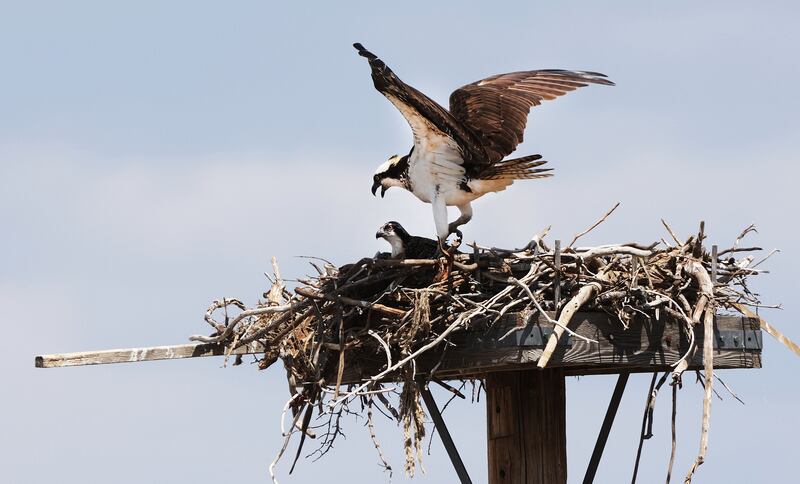Utah crops are suffering or fields are fallow, cattle are sold off as ranchers face a loss of rangeland, and water managers are dipping into emergency supplies as the tendrils of this extreme drought refuse to loosen their grip on the West.
“We are no longer pulling water stored from this year’s runoff. Instead, we’re relying on water that has been stored in our reservoirs during previous years. We’re pulling water from our emergency savings,” said Utah Department of Natural Resources Executive Director Brian Steed. “No one knows how long this drought will last, so it’s vital that we avoid using our stored water too quickly. Failing to save water now could lead to far more difficult circumstances later.”
As a result of the drought, farmers and ranchers are seeing water curtailments between 70% to 75%, with production yields of the state’s agricultural industry spiraling down and threatening local food security, according to information released Friday by the department.
And it’s not just farmers. The impacts of the drought threaten the Great Salt Lake ecosystem as well as boaters who hope to enjoy Utah’s reservoirs.

The Utah Department of Natural Resources grimly emphasized:
- Reservoir storage statewide continues to drop and now averages 58% (down from 59% last week). Twenty-six of Utah’s largest 42 reservoirs remain below 55% of available capacity. No additional reservoirs dropped below that threshold in the past week.
- Statewide reservoir levels are now lower than they were at the end of last year’s irrigation season in October (58% now compared to 61% in October). There are three months remaining in the irrigation season when water use is traditionally at its peak.
- Deer Creek, Jordanelle, Pineview, Rockport, Sand Hollow, Strawberry and Willard Bay are all highly visible reservoirs with storage levels below where they were at the end of the 2020 irrigation season.
The agency said low reservoir levels are being aggravated by statewide streamflows that continue to decline, with 77 of the 98 measured streams flowing below normal. This is an increase of 12 from last week.
Great Salt Lake in peril?
Water watchers are also keeping a close eye on the Great Salt Lake, which is expected to dwindle another couple of inches in the coming days. When that happens, it will reach a historic low not observed in more than 50 years — 1963.
Dropping that low is worrisome for the entire Great Salt Lake ecosystem.
Scientists from the Utah Geological Survey are concerned about the long-term implications to microbialites, which are underwater reef-like rock mounds created by millions of microbes. These structures and their microbial mats form the base of the entire ecosystem, serving as a primary food source for brine shrimp and brine flies.
“We think of these structures as living rocks,” said Michael Vanden Berg, the survey’s energy and mineral programs manager.
“They accumulate as the result of microbe communities trapping and binding sediment and/or triggering calcium carbonate minerals to precipitate from the water column. The population in Great Salt Lake is one of the largest accumulations of modern microbialites in the world,” he said.
Similar to plants, the microbes use photosynthesis to grow and bring the sun’s energy into the lake.
“Our studies show the whole lake system, including the 10 million migrating birds, depend on microbialites,” said Bonnie Baxter, director of the Great Salt Lake Institute at Westminster College. “Without these critical structures, impacts will be amplified up the food chain.”
Vanden Berg added that previous studies indicate it takes only a short period of time — maybe just weeks — for the microbial mat to die.
“It takes several years of higher lake level before the microbial mat can recover,” he said. “The exposure this fall may have lasting, unpredictable consequences for the microbialite population for years to come, even if lake levels return to higher levels in subsequent years.”
The U.S. Geological Survey, in a release issued Friday, said it is keeping close track of those levels at its Saltair measuring station.
“Based on current trends and historical data, we anticipate water levels will continue to decline over the next several months,” according to Ryan Rowland, the agency’s Utah Water Science Center Data chief. “This information is critical in helping resource managers make informed decisions on Great Salt Lake resources. You can’t manage what you don’t measure.”

Think, pray snow this winter
Across the state, reservoir and lake levels face extreme heat and low precipitation, courtesy of the continuing drought.
The Utah Division of Parks and Recreation reported additional boat ramp closures on Friday as a result of shrinking reservoirs.
Both of the boat ramps at Willard Bay State Park are now closed, along with the boat ramp at Millsite State Park. The division reported a total of seven boat ramps that are closed due to water levels. Another six of them remain under an “advisory” designation — meaning the ramp may be operating at a reduced capacity or may be at risk of closing soon.
The division said low water levels create risk of encountering hazards and it advised boat owners to check its website before heading out.
At Lake Powell, the nation’s second-largest reservoir, the Bureau of Reclamation has initiated emergency releases from the upstream Flaming Gorge Reservoir as officials worry about maintaining the hydroelectric output from the Glen Canyon Dam.
Lake Powell may reach its lowest level this month since it first began to fill in the 1960s.
Jordan Clayton, Utah snow supervisor with the Natural Resources Conservation Service, said the water year so far in 2021 has been abysmal, delivering a “paltry” 4.1 inches of precipitation, on average, at measuring sites.
“When it comes to water supply conditions in Utah’s mountains, June was not the month we were looking for. Last month’s accumulated precipitation was only 31% of normal, bringing the water-year-to-date accumulation to 64%.”
Clayton’s observations were noted in this week’s release of the July Climate and Water Report for Utah, in which he said the state’s reservoirs are unlikely to see substantial gains until next spring’s runoff.
“Based on current precipitation and soil moisture conditions, we really need next winter’s snowpack to be outstanding to preclude a continued decline in our reservoir storage levels. However, we could potentially be looking at statewide reservoir storage in the 15-20% of capacity range (or worse) by the end of next summer if conditions remain similar to this year. Water managers should take note of this potential outcome.”

Building reservoir resiliency
Tom Bruton, assistant general manager of the Central Utah Water Conservancy District, said the large reservoirs in the district’s system like Jordanelle and Strawberry are seeing their levels drop, but the system was designed for resiliency.
“The Central Utah Project is operating as designed; taking advantage of abundant water years in preparation for years of serious drought, even multiple years of serious drought. Beginning with the record-setting dry year of 2018, through the above-average year of 2019, and into the dual, record-setting drought years of 2020 and 2021, Central Utah Project deliveries have been maintained at contracted amounts.”
He said the reason for that is that these large reservoirs were constructed with a multiyear capacity in mind.
“The large reservoirs really take advantage of high runoff season. We don’t lose the water supply to spills. So it has a dual aspect — it has a large supply to take on dry years, but when we have a wet year, we have large storage where it can be filled. It is the best of both worlds.”
He added that these larger reservoirs are also critical to keeping up with rampant population increases in Utah, which remains the fastest-growing state in the nation.
“Conservation measures, such as those given at SlowtheFlow.org, buoy up and extend the water portfolios of Utah’s cities and special service districts,” Bruton said. “And as Utah continues to grow, with a majority of that growth coming from in-state increases — our children and grandchildren — water supplies need to be available so they can choose to remain in Utah if they so wish and so that others can enjoy Utah if they so decide move here.”









 alt=Amy Joi O'Donoghue
alt=Amy Joi O'Donoghue





